Financial Management Report: Decision Making, Ratio Analysis, and More
VerifiedAdded on 2023/06/04
|11
|2127
|244
Report
AI Summary
This report delves into the critical role of financial management within organizations, emphasizing its importance in planning, organizing, and controlling financial activities. It explores the nature of reporting and decision-making in accounting and financial management, highlighting how financial statements are used to assess a company's performance. The report explains the components of financial statements, including assets, liabilities, equity, revenue, and expenses. Furthermore, it examines the application of ratio analysis, including profitability, liquidity, and gearing ratios, to evaluate the financial health and performance of a UK-based medium-sized enterprise, Star Ltd, a manufacturer of AI-based toys. The report provides interpretations of the calculated ratios, identifies areas for improvement, and acknowledges the limitations of ratio analysis. The conclusion reinforces the significance of financial management and the insights gained from financial statement analysis.

Importance to
financial management
financial management
Paraphrase This Document
Need a fresh take? Get an instant paraphrase of this document with our AI Paraphraser
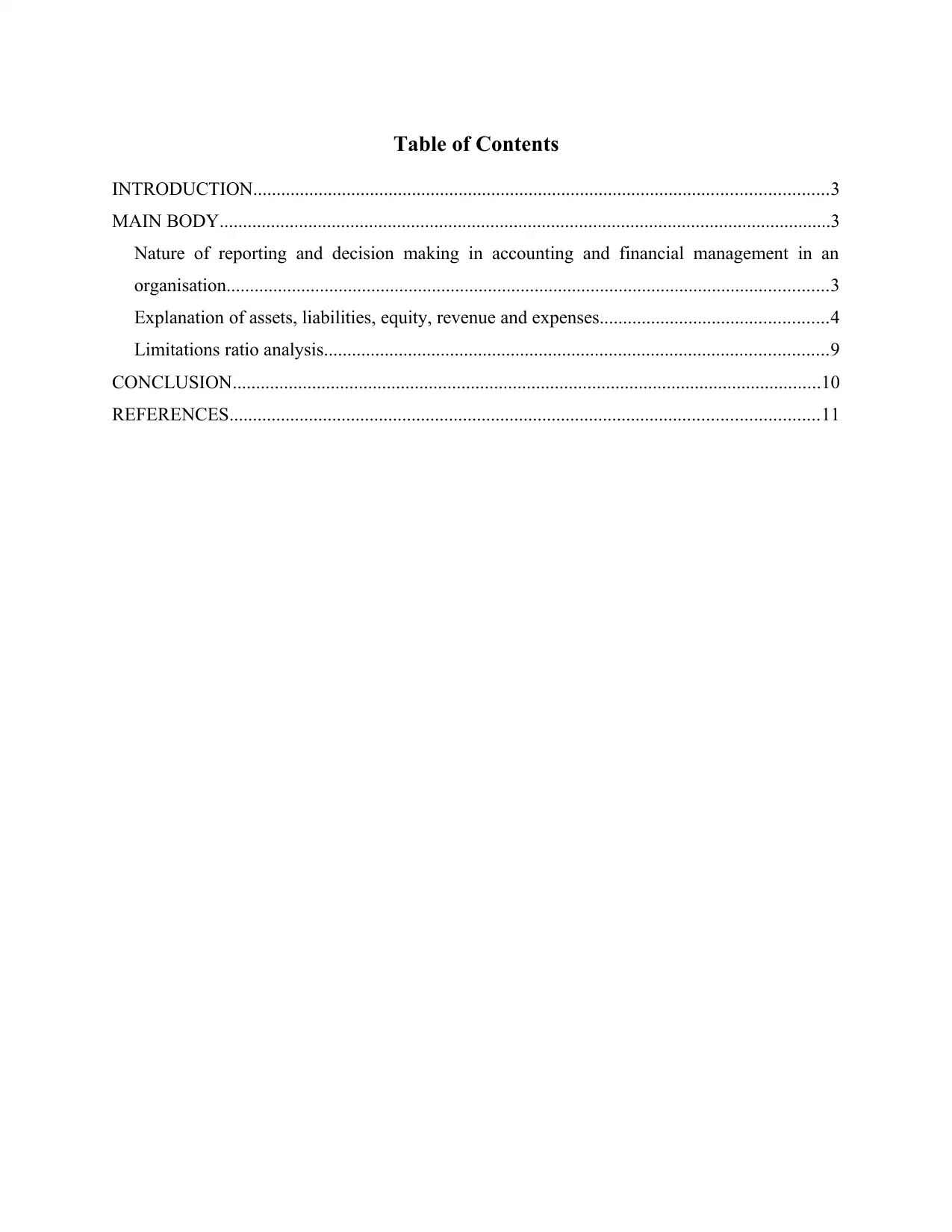
Table of Contents
INTRODUCTION...........................................................................................................................3
MAIN BODY...................................................................................................................................3
Nature of reporting and decision making in accounting and financial management in an
organisation.................................................................................................................................3
Explanation of assets, liabilities, equity, revenue and expenses.................................................4
Limitations ratio analysis............................................................................................................9
CONCLUSION..............................................................................................................................10
REFERENCES..............................................................................................................................11
INTRODUCTION...........................................................................................................................3
MAIN BODY...................................................................................................................................3
Nature of reporting and decision making in accounting and financial management in an
organisation.................................................................................................................................3
Explanation of assets, liabilities, equity, revenue and expenses.................................................4
Limitations ratio analysis............................................................................................................9
CONCLUSION..............................................................................................................................10
REFERENCES..............................................................................................................................11
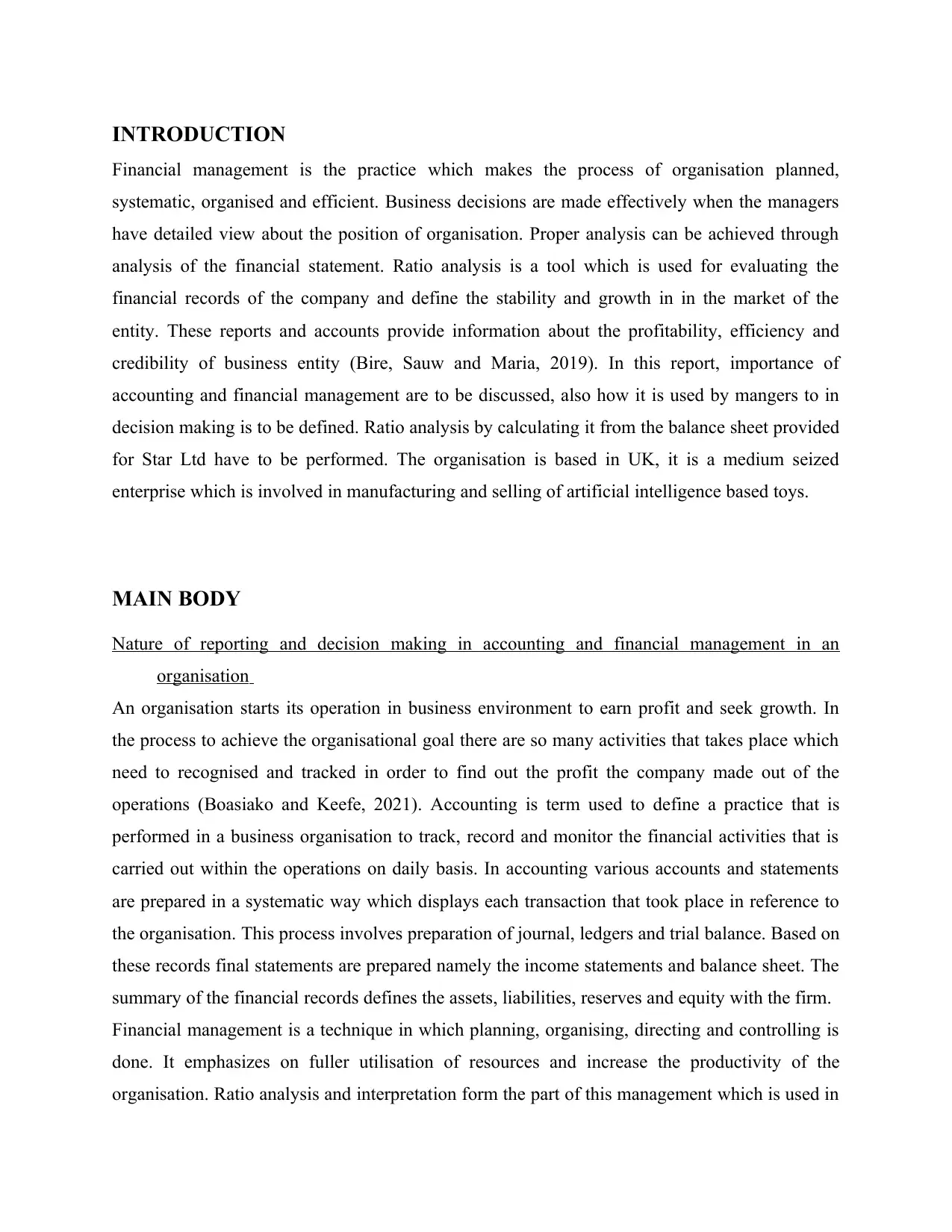
INTRODUCTION
Financial management is the practice which makes the process of organisation planned,
systematic, organised and efficient. Business decisions are made effectively when the managers
have detailed view about the position of organisation. Proper analysis can be achieved through
analysis of the financial statement. Ratio analysis is a tool which is used for evaluating the
financial records of the company and define the stability and growth in in the market of the
entity. These reports and accounts provide information about the profitability, efficiency and
credibility of business entity (Bire, Sauw and Maria, 2019). In this report, importance of
accounting and financial management are to be discussed, also how it is used by mangers to in
decision making is to be defined. Ratio analysis by calculating it from the balance sheet provided
for Star Ltd have to be performed. The organisation is based in UK, it is a medium seized
enterprise which is involved in manufacturing and selling of artificial intelligence based toys.
MAIN BODY
Nature of reporting and decision making in accounting and financial management in an
organisation
An organisation starts its operation in business environment to earn profit and seek growth. In
the process to achieve the organisational goal there are so many activities that takes place which
need to recognised and tracked in order to find out the profit the company made out of the
operations (Boasiako and Keefe, 2021). Accounting is term used to define a practice that is
performed in a business organisation to track, record and monitor the financial activities that is
carried out within the operations on daily basis. In accounting various accounts and statements
are prepared in a systematic way which displays each transaction that took place in reference to
the organisation. This process involves preparation of journal, ledgers and trial balance. Based on
these records final statements are prepared namely the income statements and balance sheet. The
summary of the financial records defines the assets, liabilities, reserves and equity with the firm.
Financial management is a technique in which planning, organising, directing and controlling is
done. It emphasizes on fuller utilisation of resources and increase the productivity of the
organisation. Ratio analysis and interpretation form the part of this management which is used in
Financial management is the practice which makes the process of organisation planned,
systematic, organised and efficient. Business decisions are made effectively when the managers
have detailed view about the position of organisation. Proper analysis can be achieved through
analysis of the financial statement. Ratio analysis is a tool which is used for evaluating the
financial records of the company and define the stability and growth in in the market of the
entity. These reports and accounts provide information about the profitability, efficiency and
credibility of business entity (Bire, Sauw and Maria, 2019). In this report, importance of
accounting and financial management are to be discussed, also how it is used by mangers to in
decision making is to be defined. Ratio analysis by calculating it from the balance sheet provided
for Star Ltd have to be performed. The organisation is based in UK, it is a medium seized
enterprise which is involved in manufacturing and selling of artificial intelligence based toys.
MAIN BODY
Nature of reporting and decision making in accounting and financial management in an
organisation
An organisation starts its operation in business environment to earn profit and seek growth. In
the process to achieve the organisational goal there are so many activities that takes place which
need to recognised and tracked in order to find out the profit the company made out of the
operations (Boasiako and Keefe, 2021). Accounting is term used to define a practice that is
performed in a business organisation to track, record and monitor the financial activities that is
carried out within the operations on daily basis. In accounting various accounts and statements
are prepared in a systematic way which displays each transaction that took place in reference to
the organisation. This process involves preparation of journal, ledgers and trial balance. Based on
these records final statements are prepared namely the income statements and balance sheet. The
summary of the financial records defines the assets, liabilities, reserves and equity with the firm.
Financial management is a technique in which planning, organising, directing and controlling is
done. It emphasizes on fuller utilisation of resources and increase the productivity of the
organisation. Ratio analysis and interpretation form the part of this management which is used in
⊘ This is a preview!⊘
Do you want full access?
Subscribe today to unlock all pages.

Trusted by 1+ million students worldwide
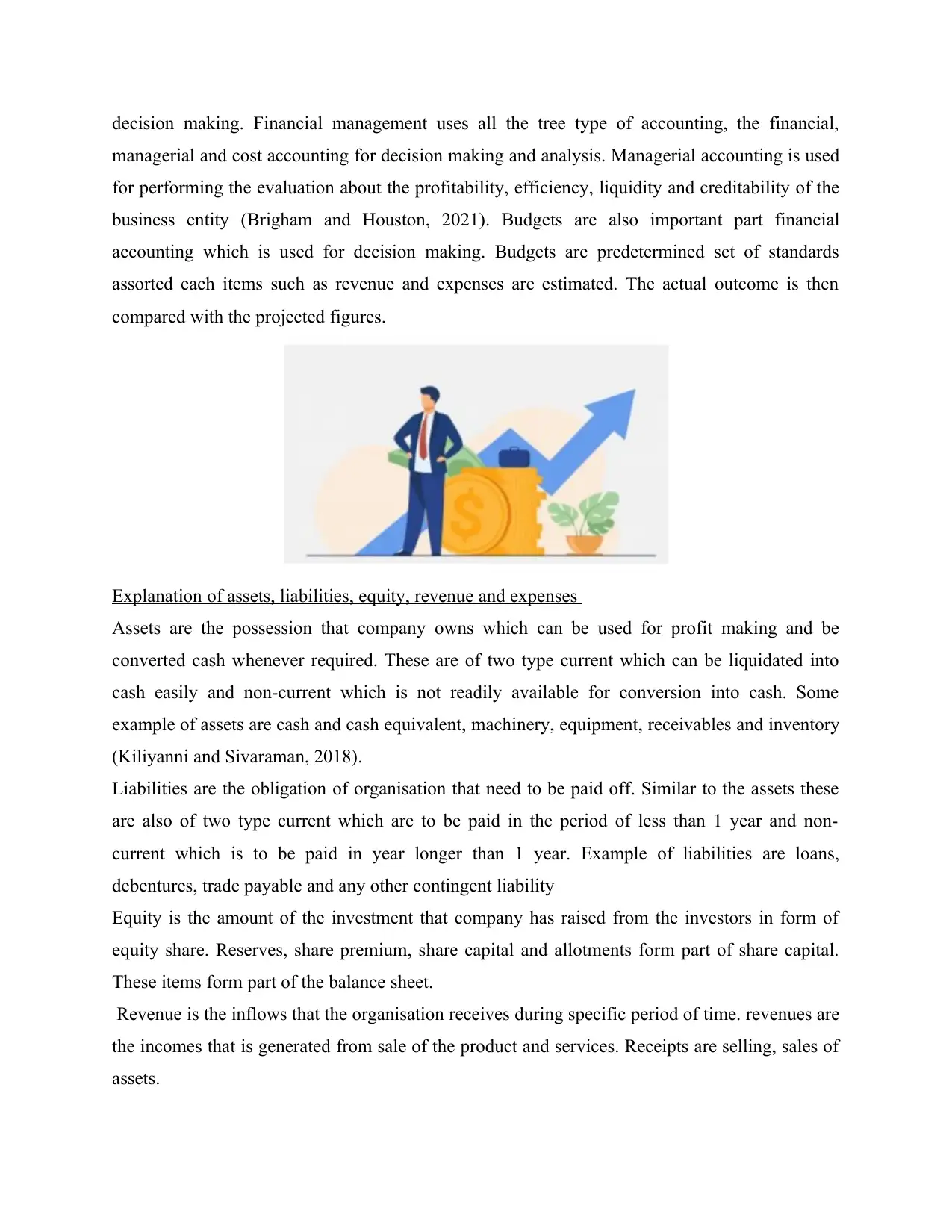
decision making. Financial management uses all the tree type of accounting, the financial,
managerial and cost accounting for decision making and analysis. Managerial accounting is used
for performing the evaluation about the profitability, efficiency, liquidity and creditability of the
business entity (Brigham and Houston, 2021). Budgets are also important part financial
accounting which is used for decision making. Budgets are predetermined set of standards
assorted each items such as revenue and expenses are estimated. The actual outcome is then
compared with the projected figures.
Explanation of assets, liabilities, equity, revenue and expenses
Assets are the possession that company owns which can be used for profit making and be
converted cash whenever required. These are of two type current which can be liquidated into
cash easily and non-current which is not readily available for conversion into cash. Some
example of assets are cash and cash equivalent, machinery, equipment, receivables and inventory
(Kiliyanni and Sivaraman, 2018).
Liabilities are the obligation of organisation that need to be paid off. Similar to the assets these
are also of two type current which are to be paid in the period of less than 1 year and non-
current which is to be paid in year longer than 1 year. Example of liabilities are loans,
debentures, trade payable and any other contingent liability
Equity is the amount of the investment that company has raised from the investors in form of
equity share. Reserves, share premium, share capital and allotments form part of share capital.
These items form part of the balance sheet.
Revenue is the inflows that the organisation receives during specific period of time. revenues are
the incomes that is generated from sale of the product and services. Receipts are selling, sales of
assets.
managerial and cost accounting for decision making and analysis. Managerial accounting is used
for performing the evaluation about the profitability, efficiency, liquidity and creditability of the
business entity (Brigham and Houston, 2021). Budgets are also important part financial
accounting which is used for decision making. Budgets are predetermined set of standards
assorted each items such as revenue and expenses are estimated. The actual outcome is then
compared with the projected figures.
Explanation of assets, liabilities, equity, revenue and expenses
Assets are the possession that company owns which can be used for profit making and be
converted cash whenever required. These are of two type current which can be liquidated into
cash easily and non-current which is not readily available for conversion into cash. Some
example of assets are cash and cash equivalent, machinery, equipment, receivables and inventory
(Kiliyanni and Sivaraman, 2018).
Liabilities are the obligation of organisation that need to be paid off. Similar to the assets these
are also of two type current which are to be paid in the period of less than 1 year and non-
current which is to be paid in year longer than 1 year. Example of liabilities are loans,
debentures, trade payable and any other contingent liability
Equity is the amount of the investment that company has raised from the investors in form of
equity share. Reserves, share premium, share capital and allotments form part of share capital.
These items form part of the balance sheet.
Revenue is the inflows that the organisation receives during specific period of time. revenues are
the incomes that is generated from sale of the product and services. Receipts are selling, sales of
assets.
Paraphrase This Document
Need a fresh take? Get an instant paraphrase of this document with our AI Paraphraser
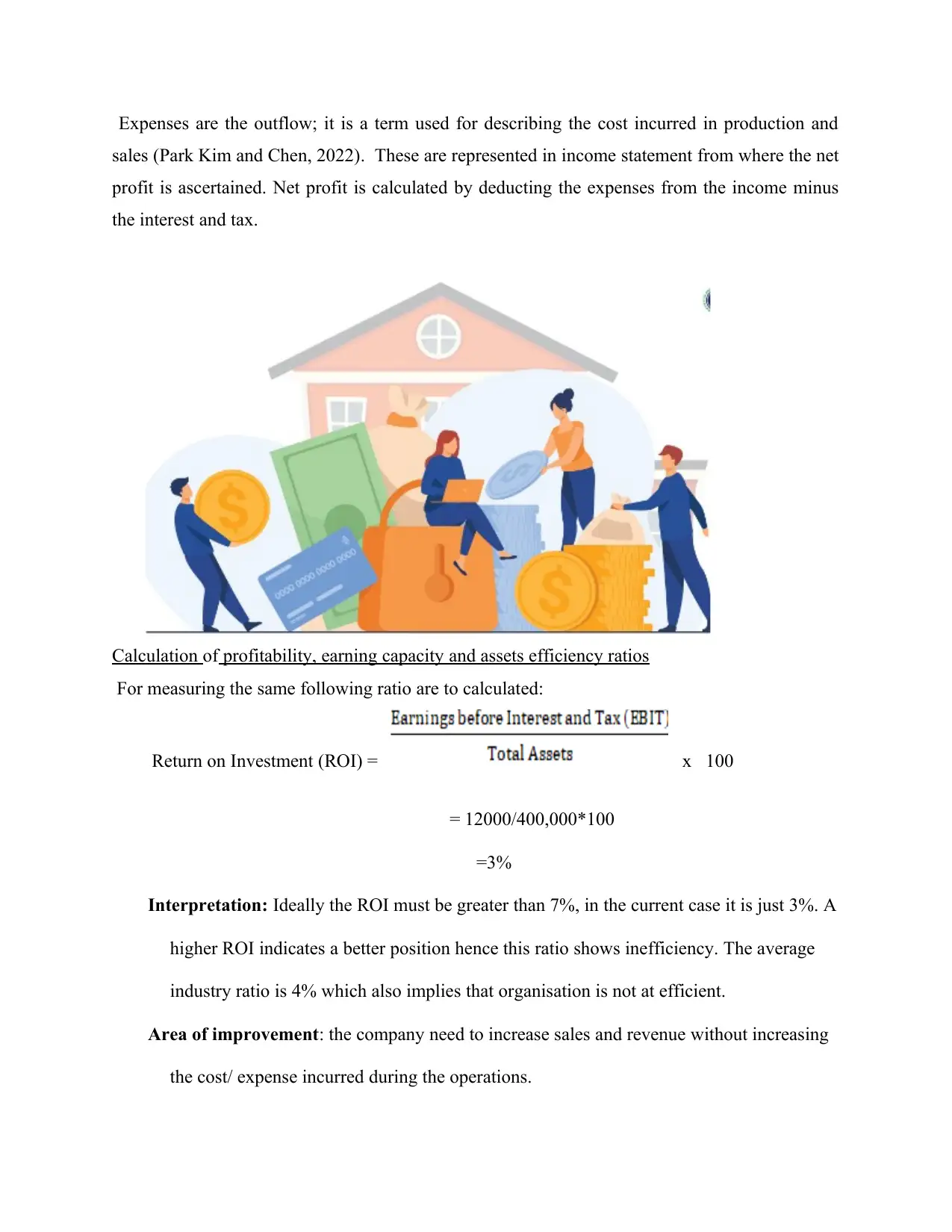
Expenses are the outflow; it is a term used for describing the cost incurred in production and
sales (Park Kim and Chen, 2022). These are represented in income statement from where the net
profit is ascertained. Net profit is calculated by deducting the expenses from the income minus
the interest and tax.
Calculation of profitability, earning capacity and assets efficiency ratios
For measuring the same following ratio are to calculated:
Return on Investment (ROI) = x 100
= 12000/400,000*100
=3%
Interpretation: Ideally the ROI must be greater than 7%, in the current case it is just 3%. A
higher ROI indicates a better position hence this ratio shows inefficiency. The average
industry ratio is 4% which also implies that organisation is not at efficient.
Area of improvement: the company need to increase sales and revenue without increasing
the cost/ expense incurred during the operations.
sales (Park Kim and Chen, 2022). These are represented in income statement from where the net
profit is ascertained. Net profit is calculated by deducting the expenses from the income minus
the interest and tax.
Calculation of profitability, earning capacity and assets efficiency ratios
For measuring the same following ratio are to calculated:
Return on Investment (ROI) = x 100
= 12000/400,000*100
=3%
Interpretation: Ideally the ROI must be greater than 7%, in the current case it is just 3%. A
higher ROI indicates a better position hence this ratio shows inefficiency. The average
industry ratio is 4% which also implies that organisation is not at efficient.
Area of improvement: the company need to increase sales and revenue without increasing
the cost/ expense incurred during the operations.
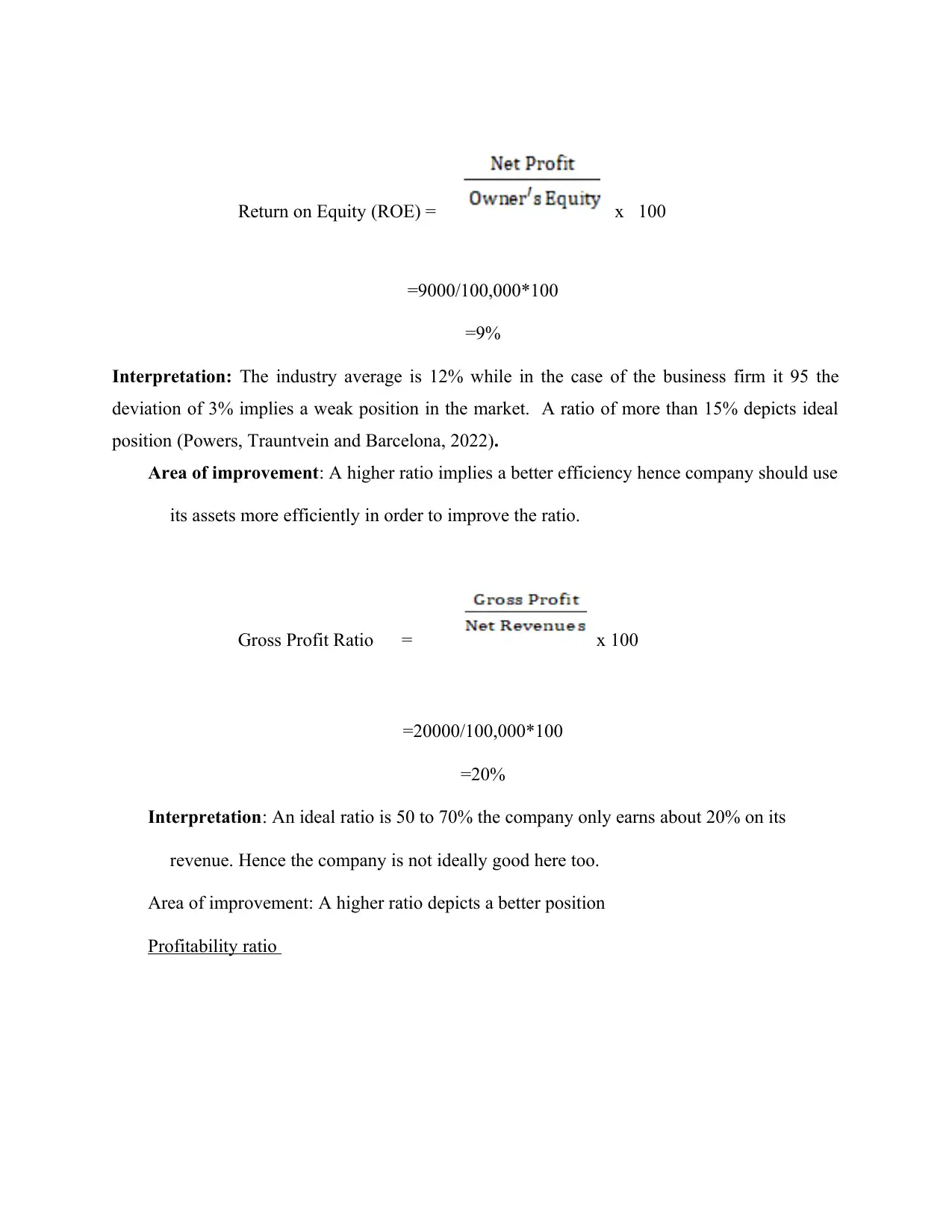
Return on Equity (ROE) = x 100
=9000/100,000*100
=9%
Interpretation: The industry average is 12% while in the case of the business firm it 95 the
deviation of 3% implies a weak position in the market. A ratio of more than 15% depicts ideal
position (Powers, Trauntvein and Barcelona, 2022).
Area of improvement: A higher ratio implies a better efficiency hence company should use
its assets more efficiently in order to improve the ratio.
Gross Profit Ratio = x 100
=20000/100,000*100
=20%
Interpretation: An ideal ratio is 50 to 70% the company only earns about 20% on its
revenue. Hence the company is not ideally good here too.
Area of improvement: A higher ratio depicts a better position
Profitability ratio
=9000/100,000*100
=9%
Interpretation: The industry average is 12% while in the case of the business firm it 95 the
deviation of 3% implies a weak position in the market. A ratio of more than 15% depicts ideal
position (Powers, Trauntvein and Barcelona, 2022).
Area of improvement: A higher ratio implies a better efficiency hence company should use
its assets more efficiently in order to improve the ratio.
Gross Profit Ratio = x 100
=20000/100,000*100
=20%
Interpretation: An ideal ratio is 50 to 70% the company only earns about 20% on its
revenue. Hence the company is not ideally good here too.
Area of improvement: A higher ratio depicts a better position
Profitability ratio
⊘ This is a preview!⊘
Do you want full access?
Subscribe today to unlock all pages.

Trusted by 1+ million students worldwide
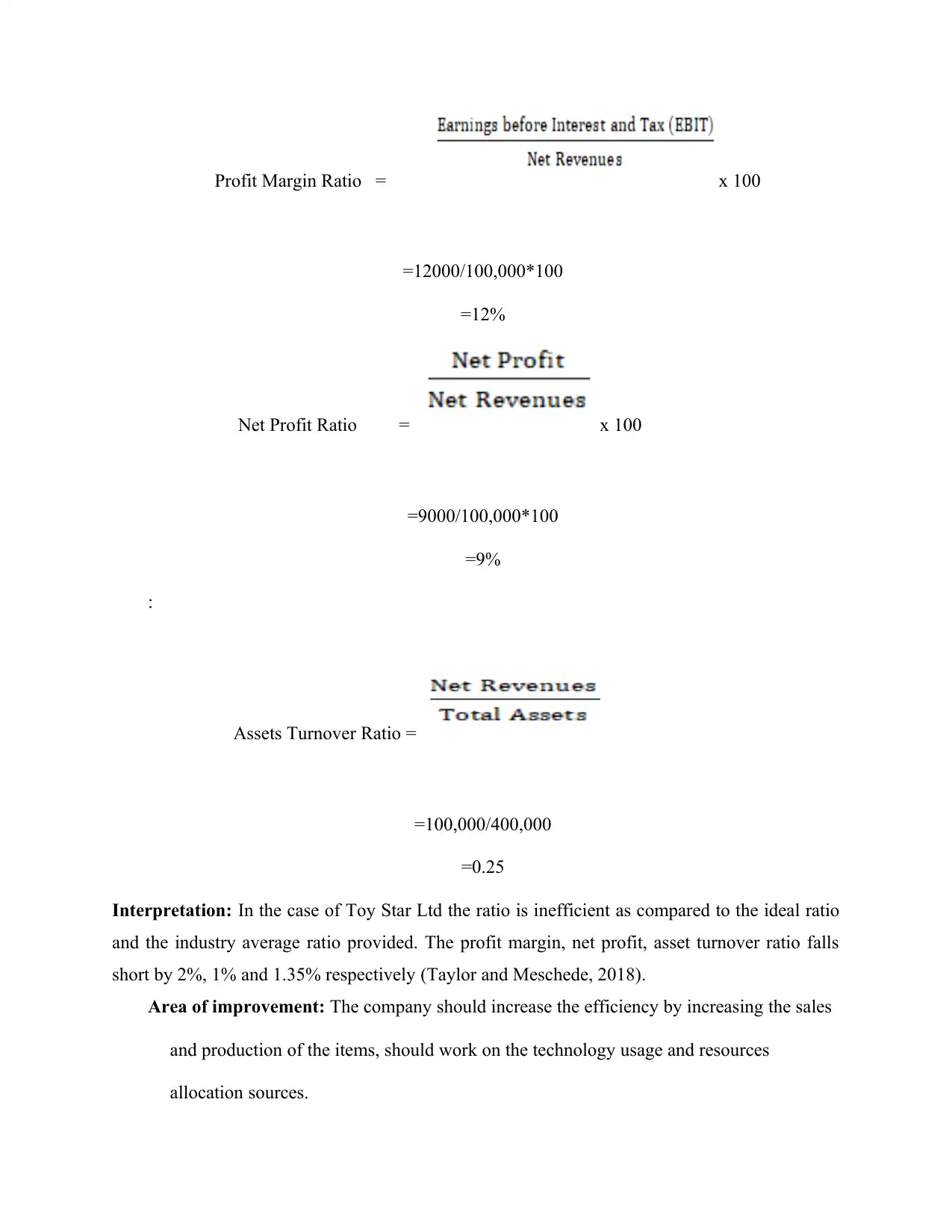
Profit Margin Ratio = x 100
=12000/100,000*100
=12%
Net Profit Ratio = x 100
=9000/100,000*100
=9%
:
Assets Turnover Ratio =
=100,000/400,000
=0.25
Interpretation: In the case of Toy Star Ltd the ratio is inefficient as compared to the ideal ratio
and the industry average ratio provided. The profit margin, net profit, asset turnover ratio falls
short by 2%, 1% and 1.35% respectively (Taylor and Meschede, 2018).
Area of improvement: The company should increase the efficiency by increasing the sales
and production of the items, should work on the technology usage and resources
allocation sources.
=12000/100,000*100
=12%
Net Profit Ratio = x 100
=9000/100,000*100
=9%
:
Assets Turnover Ratio =
=100,000/400,000
=0.25
Interpretation: In the case of Toy Star Ltd the ratio is inefficient as compared to the ideal ratio
and the industry average ratio provided. The profit margin, net profit, asset turnover ratio falls
short by 2%, 1% and 1.35% respectively (Taylor and Meschede, 2018).
Area of improvement: The company should increase the efficiency by increasing the sales
and production of the items, should work on the technology usage and resources
allocation sources.
Paraphrase This Document
Need a fresh take? Get an instant paraphrase of this document with our AI Paraphraser
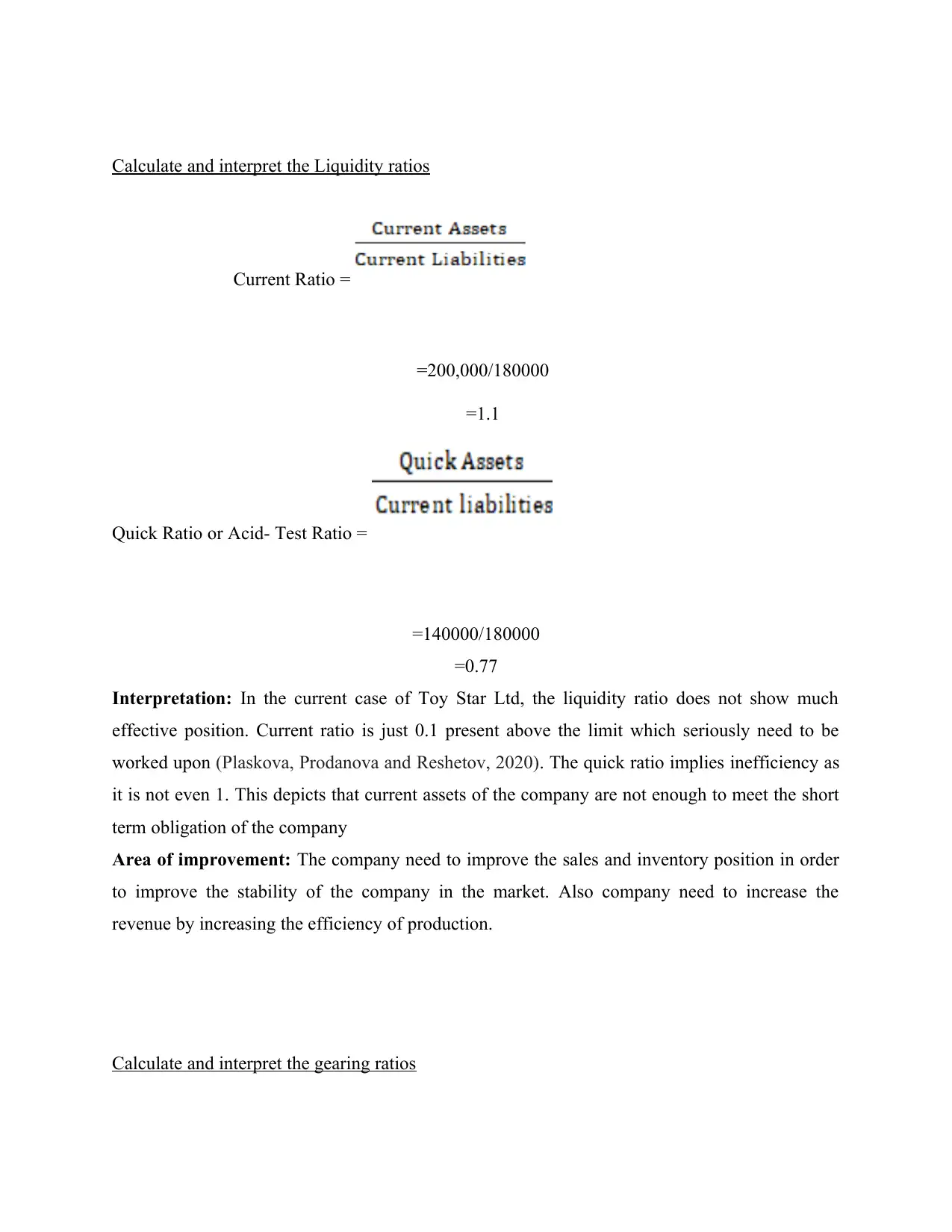
Calculate and interpret the Liquidity ratios
Current Ratio =
=200,000/180000
=1.1
Quick Ratio or Acid- Test Ratio =
=140000/180000
=0.77
Interpretation: In the current case of Toy Star Ltd, the liquidity ratio does not show much
effective position. Current ratio is just 0.1 present above the limit which seriously need to be
worked upon (Plaskova, Prodanova and Reshetov, 2020). The quick ratio implies inefficiency as
it is not even 1. This depicts that current assets of the company are not enough to meet the short
term obligation of the company
Area of improvement: The company need to improve the sales and inventory position in order
to improve the stability of the company in the market. Also company need to increase the
revenue by increasing the efficiency of production.
Calculate and interpret the gearing ratios
Current Ratio =
=200,000/180000
=1.1
Quick Ratio or Acid- Test Ratio =
=140000/180000
=0.77
Interpretation: In the current case of Toy Star Ltd, the liquidity ratio does not show much
effective position. Current ratio is just 0.1 present above the limit which seriously need to be
worked upon (Plaskova, Prodanova and Reshetov, 2020). The quick ratio implies inefficiency as
it is not even 1. This depicts that current assets of the company are not enough to meet the short
term obligation of the company
Area of improvement: The company need to improve the sales and inventory position in order
to improve the stability of the company in the market. Also company need to increase the
revenue by increasing the efficiency of production.
Calculate and interpret the gearing ratios
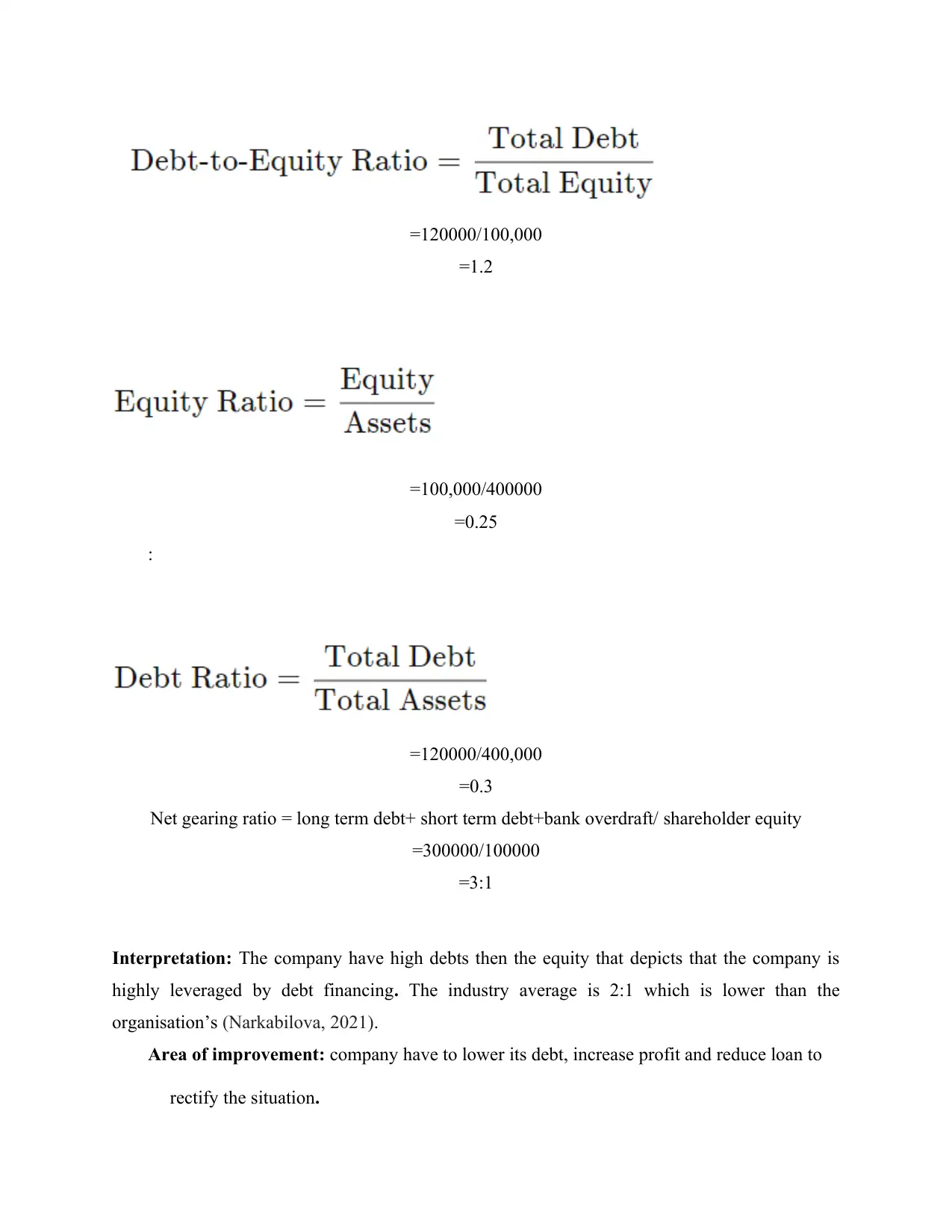
=120000/100,000
=1.2
=100,000/400000
=0.25
:
=120000/400,000
=0.3
Net gearing ratio = long term debt+ short term debt+bank overdraft/ shareholder equity
=300000/100000
=3:1
Interpretation: The company have high debts then the equity that depicts that the company is
highly leveraged by debt financing. The industry average is 2:1 which is lower than the
organisation’s (Narkabilova, 2021).
Area of improvement: company have to lower its debt, increase profit and reduce loan to
rectify the situation.
=1.2
=100,000/400000
=0.25
:
=120000/400,000
=0.3
Net gearing ratio = long term debt+ short term debt+bank overdraft/ shareholder equity
=300000/100000
=3:1
Interpretation: The company have high debts then the equity that depicts that the company is
highly leveraged by debt financing. The industry average is 2:1 which is lower than the
organisation’s (Narkabilova, 2021).
Area of improvement: company have to lower its debt, increase profit and reduce loan to
rectify the situation.
⊘ This is a preview!⊘
Do you want full access?
Subscribe today to unlock all pages.

Trusted by 1+ million students worldwide
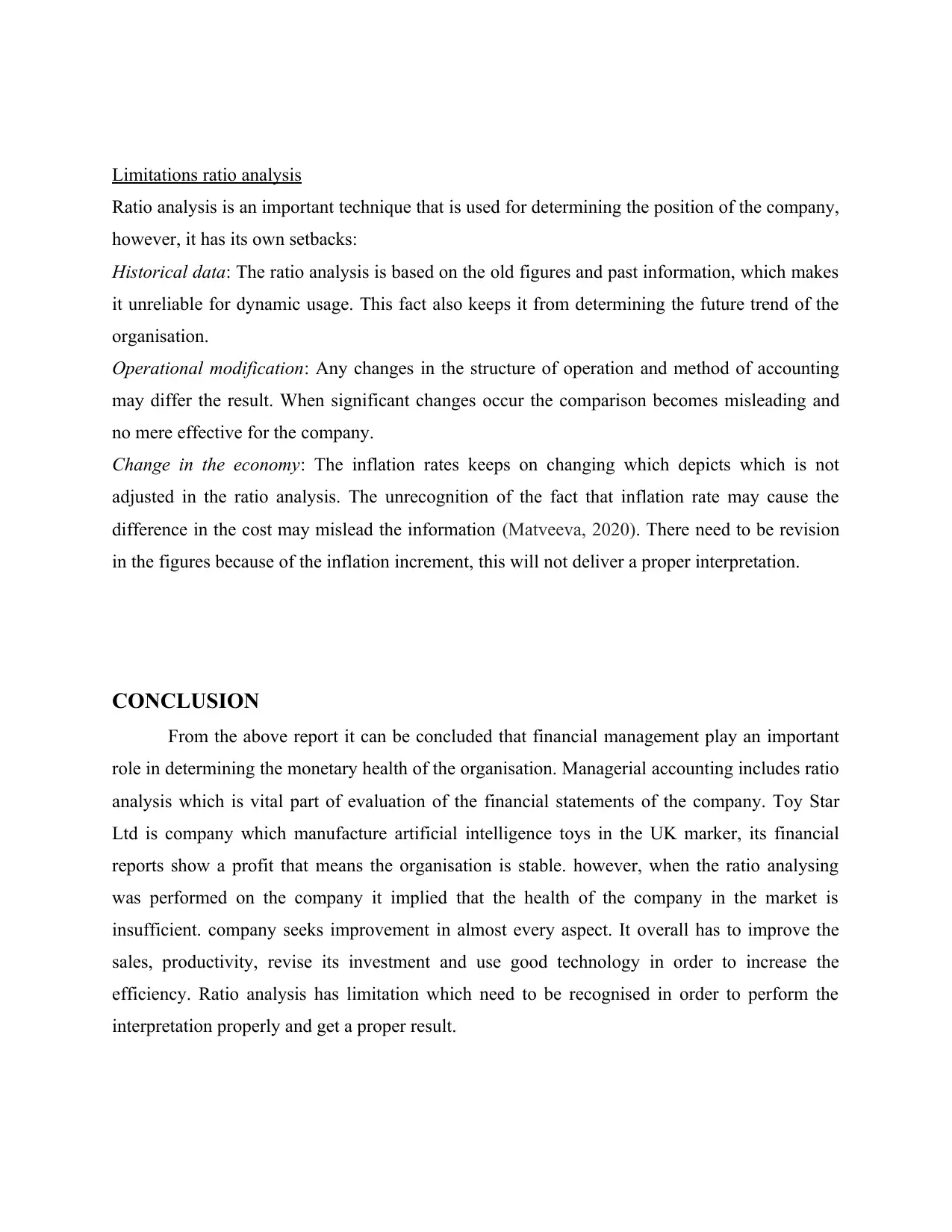
Limitations ratio analysis
Ratio analysis is an important technique that is used for determining the position of the company,
however, it has its own setbacks:
Historical data: The ratio analysis is based on the old figures and past information, which makes
it unreliable for dynamic usage. This fact also keeps it from determining the future trend of the
organisation.
Operational modification: Any changes in the structure of operation and method of accounting
may differ the result. When significant changes occur the comparison becomes misleading and
no mere effective for the company.
Change in the economy: The inflation rates keeps on changing which depicts which is not
adjusted in the ratio analysis. The unrecognition of the fact that inflation rate may cause the
difference in the cost may mislead the information (Matveeva, 2020). There need to be revision
in the figures because of the inflation increment, this will not deliver a proper interpretation.
CONCLUSION
From the above report it can be concluded that financial management play an important
role in determining the monetary health of the organisation. Managerial accounting includes ratio
analysis which is vital part of evaluation of the financial statements of the company. Toy Star
Ltd is company which manufacture artificial intelligence toys in the UK marker, its financial
reports show a profit that means the organisation is stable. however, when the ratio analysing
was performed on the company it implied that the health of the company in the market is
insufficient. company seeks improvement in almost every aspect. It overall has to improve the
sales, productivity, revise its investment and use good technology in order to increase the
efficiency. Ratio analysis has limitation which need to be recognised in order to perform the
interpretation properly and get a proper result.
Ratio analysis is an important technique that is used for determining the position of the company,
however, it has its own setbacks:
Historical data: The ratio analysis is based on the old figures and past information, which makes
it unreliable for dynamic usage. This fact also keeps it from determining the future trend of the
organisation.
Operational modification: Any changes in the structure of operation and method of accounting
may differ the result. When significant changes occur the comparison becomes misleading and
no mere effective for the company.
Change in the economy: The inflation rates keeps on changing which depicts which is not
adjusted in the ratio analysis. The unrecognition of the fact that inflation rate may cause the
difference in the cost may mislead the information (Matveeva, 2020). There need to be revision
in the figures because of the inflation increment, this will not deliver a proper interpretation.
CONCLUSION
From the above report it can be concluded that financial management play an important
role in determining the monetary health of the organisation. Managerial accounting includes ratio
analysis which is vital part of evaluation of the financial statements of the company. Toy Star
Ltd is company which manufacture artificial intelligence toys in the UK marker, its financial
reports show a profit that means the organisation is stable. however, when the ratio analysing
was performed on the company it implied that the health of the company in the market is
insufficient. company seeks improvement in almost every aspect. It overall has to improve the
sales, productivity, revise its investment and use good technology in order to increase the
efficiency. Ratio analysis has limitation which need to be recognised in order to perform the
interpretation properly and get a proper result.
Paraphrase This Document
Need a fresh take? Get an instant paraphrase of this document with our AI Paraphraser
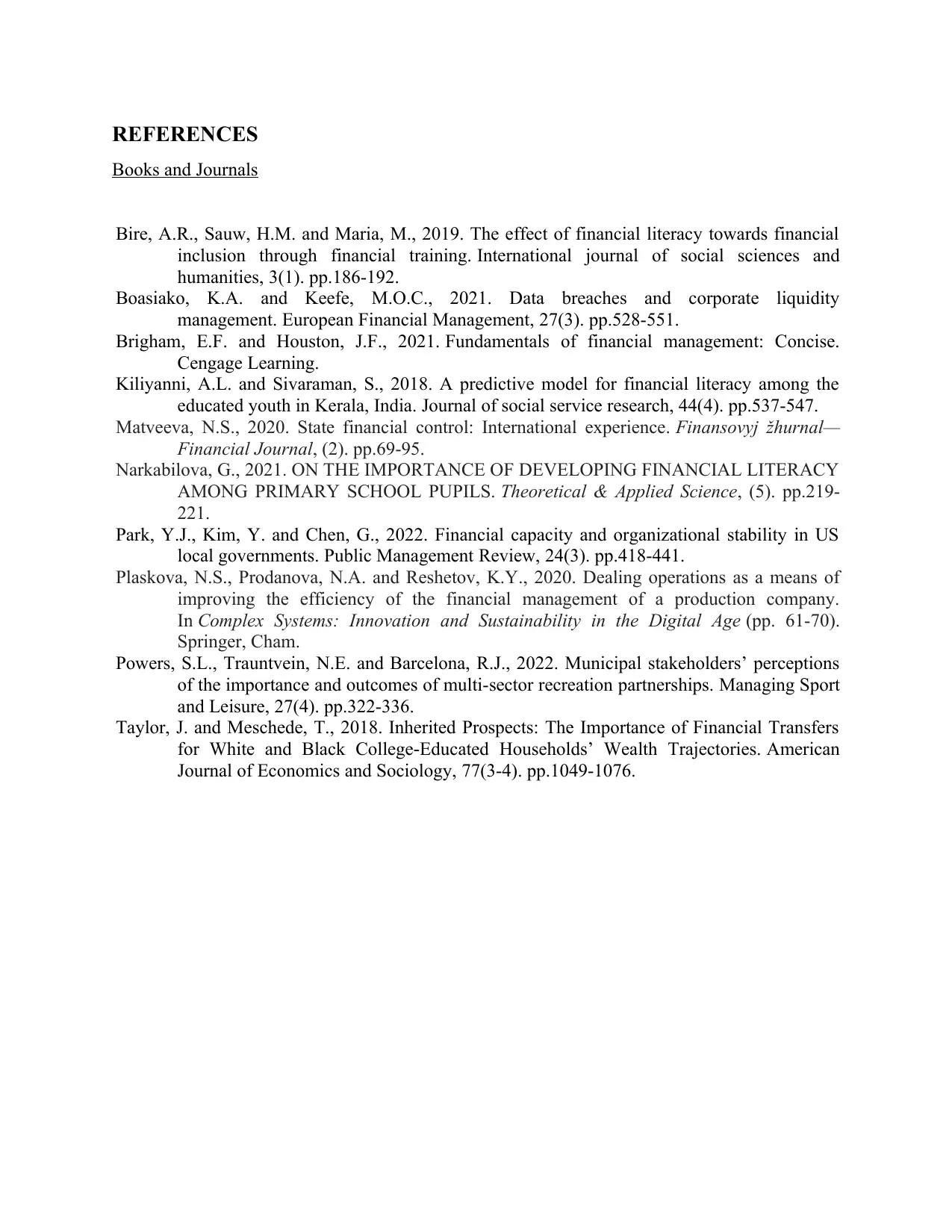
REFERENCES
Books and Journals
Bire, A.R., Sauw, H.M. and Maria, M., 2019. The effect of financial literacy towards financial
inclusion through financial training. International journal of social sciences and
humanities, 3(1). pp.186-192.
Boasiako, K.A. and Keefe, M.O.C., 2021. Data breaches and corporate liquidity
management. European Financial Management, 27(3). pp.528-551.
Brigham, E.F. and Houston, J.F., 2021. Fundamentals of financial management: Concise.
Cengage Learning.
Kiliyanni, A.L. and Sivaraman, S., 2018. A predictive model for financial literacy among the
educated youth in Kerala, India. Journal of social service research, 44(4). pp.537-547.
Matveeva, N.S., 2020. State financial control: International experience. Finansovyj žhurnal—
Financial Journal, (2). pp.69-95.
Narkabilova, G., 2021. ON THE IMPORTANCE OF DEVELOPING FINANCIAL LITERACY
AMONG PRIMARY SCHOOL PUPILS. Theoretical & Applied Science, (5). pp.219-
221.
Park, Y.J., Kim, Y. and Chen, G., 2022. Financial capacity and organizational stability in US
local governments. Public Management Review, 24(3). pp.418-441.
Plaskova, N.S., Prodanova, N.A. and Reshetov, K.Y., 2020. Dealing operations as a means of
improving the efficiency of the financial management of a production company.
In Complex Systems: Innovation and Sustainability in the Digital Age (pp. 61-70).
Springer, Cham.
Powers, S.L., Trauntvein, N.E. and Barcelona, R.J., 2022. Municipal stakeholders’ perceptions
of the importance and outcomes of multi-sector recreation partnerships. Managing Sport
and Leisure, 27(4). pp.322-336.
Taylor, J. and Meschede, T., 2018. Inherited Prospects: The Importance of Financial Transfers
for White and Black College Educated Households’ Wealth Trajectories.‐ American
Journal of Economics and Sociology, 77(3-4). pp.1049-1076.
Books and Journals
Bire, A.R., Sauw, H.M. and Maria, M., 2019. The effect of financial literacy towards financial
inclusion through financial training. International journal of social sciences and
humanities, 3(1). pp.186-192.
Boasiako, K.A. and Keefe, M.O.C., 2021. Data breaches and corporate liquidity
management. European Financial Management, 27(3). pp.528-551.
Brigham, E.F. and Houston, J.F., 2021. Fundamentals of financial management: Concise.
Cengage Learning.
Kiliyanni, A.L. and Sivaraman, S., 2018. A predictive model for financial literacy among the
educated youth in Kerala, India. Journal of social service research, 44(4). pp.537-547.
Matveeva, N.S., 2020. State financial control: International experience. Finansovyj žhurnal—
Financial Journal, (2). pp.69-95.
Narkabilova, G., 2021. ON THE IMPORTANCE OF DEVELOPING FINANCIAL LITERACY
AMONG PRIMARY SCHOOL PUPILS. Theoretical & Applied Science, (5). pp.219-
221.
Park, Y.J., Kim, Y. and Chen, G., 2022. Financial capacity and organizational stability in US
local governments. Public Management Review, 24(3). pp.418-441.
Plaskova, N.S., Prodanova, N.A. and Reshetov, K.Y., 2020. Dealing operations as a means of
improving the efficiency of the financial management of a production company.
In Complex Systems: Innovation and Sustainability in the Digital Age (pp. 61-70).
Springer, Cham.
Powers, S.L., Trauntvein, N.E. and Barcelona, R.J., 2022. Municipal stakeholders’ perceptions
of the importance and outcomes of multi-sector recreation partnerships. Managing Sport
and Leisure, 27(4). pp.322-336.
Taylor, J. and Meschede, T., 2018. Inherited Prospects: The Importance of Financial Transfers
for White and Black College Educated Households’ Wealth Trajectories.‐ American
Journal of Economics and Sociology, 77(3-4). pp.1049-1076.
1 out of 11
Related Documents
Your All-in-One AI-Powered Toolkit for Academic Success.
+13062052269
info@desklib.com
Available 24*7 on WhatsApp / Email
![[object Object]](/_next/static/media/star-bottom.7253800d.svg)
Unlock your academic potential
Copyright © 2020–2025 A2Z Services. All Rights Reserved. Developed and managed by ZUCOL.





